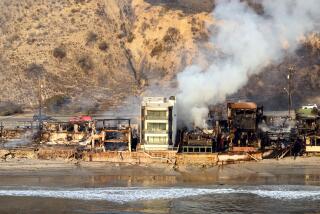The Nuts and Bolts of Securing a House to Its Foundation
- Share via
The way Ed Sylvis sees it, houses don’t slide off their foundations during earthquakes. It’s the foundation that slides out from under the house.
“It’s like pulling a carpet out from under it,” said Sylvis, owner of Seismic Safety in Pasadena and co-founder of the Southern California Assn. of Residential Retrofit Professionals.
That’s a long way of saying people should bolt houses to their foundations so that the two stick together in a quake. And city inspectors say that while Monday’s quake is fresh on your mind, you might want to think about doing just that if you have an older house.
“If you have a building that is not secured, is not seismic safe, then you have trouble,” said Roy Streeter, the building official for the city of Arcadia.
Retrofitting usually involves bolting, then shoring up what are called cripple walls--wooden outer walls that elevate your floor off the ground.
The easiest way to know if your house might need retrofitting is to look underneath it. If you can’t because there’s solid concrete between your house and the ground or if you pull up your carpet and there’s nothing but concrete underneath, then your house was built on a slab foundation and was very likely bolted down when it was built. If you have a crawl space, your house could be a retrofit candidate.
Most city building inspectors will be glad to check your house for seismic safety, especially since retrofitting requires a building permit. According to staff structural engineer Fred Turner, of the state Seismic Safety Commission, the inspectors can also tell you whether it’s a do-it-yourself project.
Before World War II, houses were often built so that they rested on their foundations with nothing but gravity to keep them there. When the ground starts shaking, gravity loses to other forces.
Retrofitters bolt the house onto a concrete foundation with 9-inch-by-9-inch steel plates all along the interior of the crawl space. They also add framing anchors every few inches. If the house is resting on cripple walls, they add plywood reinforcements.
The cost of retrofitting is fairly minimal compared to most other home improvements. The work usually ranges between $1,800 to $5,000 for a conventional house. Houses with bad foundations, rock foundations or pier- and post-foundations can cost considerably more.
San Marino resident Lorraine Saunders spent $2,800 to bolt down her 1927 two-story house, a job that was finished just last week. Even before Monday, she considered it a good investment. Now she thinks it was a great investment. As she rode out the earthquake in her bed, “I thought, we’ve done what we can. We’ve done the best we can.”
Homeowners need to be aware of unscrupulous or incompetent contractors.
“Unfortunately, what we do is in an area most people don’t look,” said Craig Boatman of Seismic Safety.
“Anybody can do it. The fact is some people just aren’t set up (for it). It’s always a good idea to use somebody who has some experience,” said South Pasadena director of community development Bill Campbell. His job includes checking retrofitting plans.
Architect Elizabeth Meaves, associate director of Pasadena Heritage’s preservation fund, also recommends using a seismic safety specialist, and said word of mouth or contacting your local historical society are the best ways to find one.
Consumers should also call the Contractors State License Board information line (800) 321-2752 for the free booklet “What You Should Know Before You Hire a Contractor.”
Will retrofitting hold through an earthquake of magnitude 8 on the Richter scale? Sylvis said yes, adding that if the house “went cartwheeling down the street,” the foundation would still be attached.
However, Bill Liebman, owner of Cal-Seismics, another retrofitter, said, “What it will withstand, nobody can say. Once this system is in place, the next weak point in the chain is the materials in the house.”
More to Read
Sign up for Essential California
The most important California stories and recommendations in your inbox every morning.
You may occasionally receive promotional content from the Los Angeles Times.










